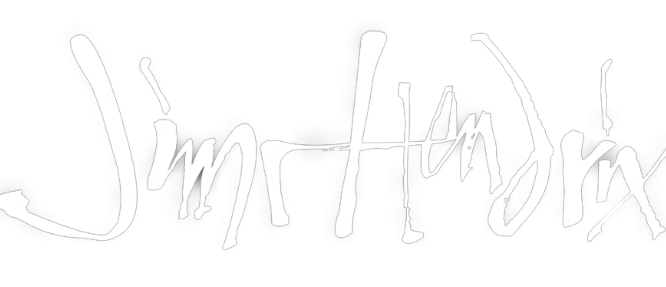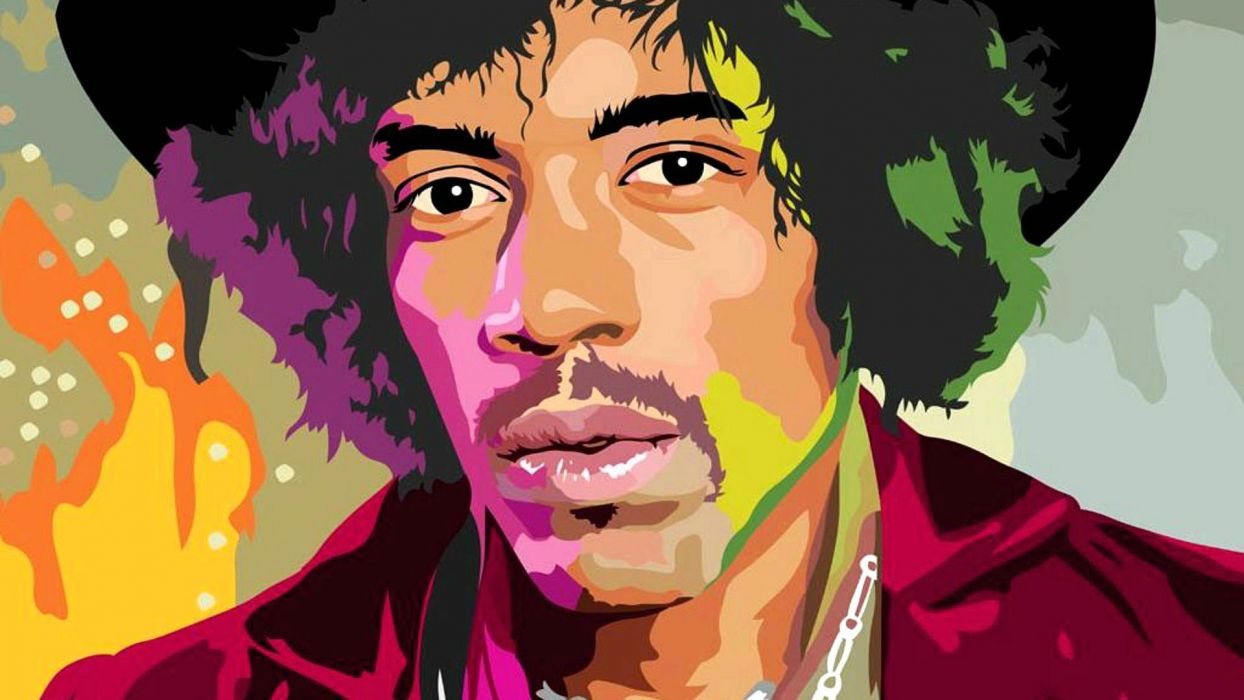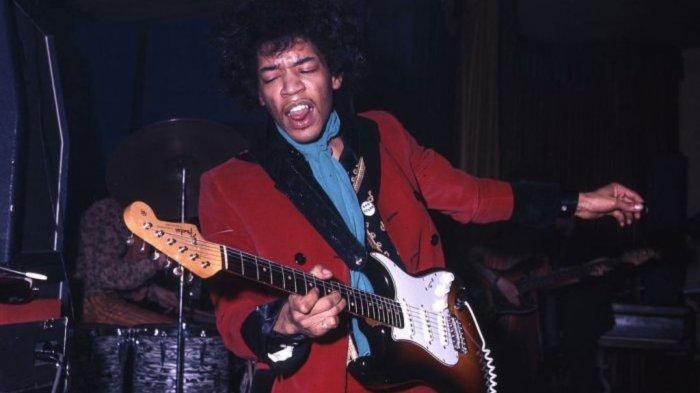Woodstock
By 1969, Jimi Hendrix was the world's highest-paid rock musician. In August, he headlined the Woodstock Music and Art Fair that included many of the most popular bands of the time. For the concert, he added rhythm guitarist Larry Lee and conga players Juma Sultan and Jerry Velez. The band rehearsed for less than two weeks before the performance, and according to Mitchell, they never connected musically. Before arriving at the engagement, Hendrix heard reports that the size of the audience had grown enormously, which concerned him as he did not enjoy performing for large crowds. He was an important draw for the event, and although he accepted substantially less money for the appearance than his usual fee, he was the festival's highest-paid performer.
Jimi Hendrix decided to move his midnight Sunday slot to Monday morning, closing the show. The band took the stage around 8:00 a.m, by which time Hendrix had been awake for more than three days. The audience, which peaked at an estimated 400,000 people, was reduced to 30,000. The festival MC, Chip Monck, introduced the group as "The Jimi Hendrix Experience", but Hendrix clarified: "We decided to change the whole thing around and call it 'Gypsy Sun and Rainbows'. For short, it's nothin' but a 'Band of Gypsys'."
Hendrix's performance included a rendition of the US national anthem, "The Star-Spangled Banner", with copious feedback, distortion, and sustain to imitate the sounds made by rockets and bombs. Contemporary political pundits described his interpretation as a statement against the Vietnam War. Three weeks later Hendrix said: "We're all Americans ... it was like 'Go America!'... We play it the way the air is in America today. The air is slightly static, see." Immortalized in the 1970 documentary film, Woodstock, Hendrix's version became part of the sixties zeitgeist. Pop critic Al Aronowitz of the New York Post wrote: "It was the most electrifying moment of Woodstock, and it was probably the single greatest moment of the sixties."

Images of the performance showing Hendrix wearing a blue-beaded white leather jacket with fringe, a red head-scarf, and blue jeans are regarded as iconic pictures that capture a defining moment of the era. He played "Hey Joe" during the encore, concluding the 31⁄2-day festival. Upon leaving the stage, he collapsed from exhaustion. In 2011, the editors of Guitar World named his performance of "The Star-Spangled Banner" the greatest performance of all time.
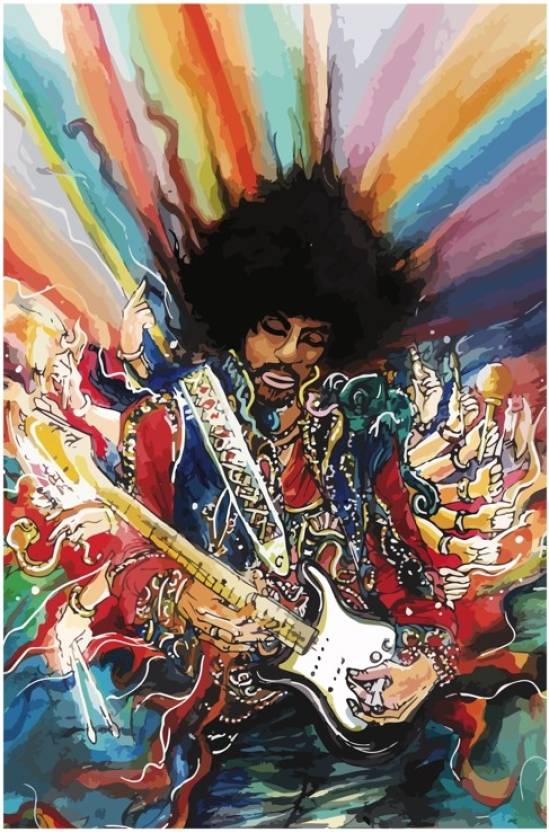
Band of Gypsys
A legal dispute arose in 1966 regarding a record contract that Jimi Hendrix had entered into the previous year with producer Ed Chalpin. After two years of litigation, the parties agreed to a resolution that granted Chalpin the distribution rights to an album of original Hendrix material. Hendrix decided that they would record the LP, Band of Gypsys, during two live appearances. In preparation for the shows he formed an all-black power trio with Billy Cox and drummer Buddy Miles, formerly with Wilson Pickett, The Electric Flag, and the Buddy Miles Express.
Critic John Rockwell described Jimi Hendrix and Buddy Miles as jazz-rock fusionists, and their collaboration as pioneering. Others identified a Funk and Soul influence in their music. Concert promoter Bill Graham called the shows "the most brilliant, emotional display of virtuoso electric guitar" that he had ever heard. Biographers have speculated that Hendrix formed the band in an effort to appease members of the Black Power movement and others in the black communities who called for him to use his fame to speak up for civil rights.
Jimi Hendrix had been recording with Billy Cox since April and jamming with Buddy Miles since September, and the trio wrote and rehearsed material which they performed at a series of four shows over two nights on December 31 and January 1, at the Fillmore East. They used recordings of these concerts to assemble the LP, which was produced by Hendrix.
The album includes the track "Machine Gun", which musicologist Andy Aledort described as the pinnacle of Hendrix's career, and "the premiere example of his unparalleled genius as a rock guitarist ... In this performance, Jimi transcended the medium of rock music, and set an entirely new standard for the potential of electric guitar." During the song's extended instrumental breaks, Hendrix created sounds with his guitar that sonically represented warfare, including rockets, bombs, and diving planes.
The Band of Gypsys album was the only official live Hendrix LP made commercially available during his lifetime; several tracks from the Woodstock and Monterey shows were released later that year. The album was released in April 1970 by Capitol Records; it reached the top ten in both the US and the UK. That same month a single was issued with "Stepping Stone" as the A-side and "Izabella" as the B-side, but Jimi Hendrix was dissatisfied with the quality of the mastering and he demanded that it be withdrawn and re-mixed, preventing the songs from charting and resulting in Hendrix's least successful single; it was also his last.
On January 28, 1970, a third and final Band of Gypsys appearance took place; they performed during a music festival at Madison Square Garden benefiting the anti-Vietnam War Moratorium Committee titled the "Winter Festival for Peace". American blues guitarist Johnny Winter was backstage before the concert; he recalled: "Hendrix came in with his head down, sat on the couch alone, and put his head in his hands ... He didn't move until it was time for the show." Minutes after taking the stage he snapped a vulgar response at a woman who had shouted a request for "Foxy Lady". He then began playing "Earth Blues" before telling the audience: "That's what happens when earth fucks with space". Moments later, he briefly sat down on the drum riser before leaving the stage. Both Miles and Redding later stated that Jeffery had given Hendrix LSD before the performance. Miles believed that Jeffery gave Hendrix the drugs in an effort to sabotage the current band and bring about the return of the original Experience lineup. Jeffery fired Miles after the show and Cox quit, ending the Band of Gypsys.
Cry of Love Tour
Soon after the abruptly ended Band of Gypsys performance and their subsequent dissolution, Jeffery made arrangements to reunite the original Experience lineup. Although Hendrix, Mitchell, and Redding were interviewed by Rolling Stone in February 1970 as a united group, Hendrix never intended to work with Redding. When Redding returned to New York in anticipation of rehearsals with a re-formed Experience, he was told that he had been replaced with Cox.
During an interview with Rolling Stone's Keith Altham, Hendrix defended the decision: "It's nothing personal against Noel, but we finished what we were doing with the Experience and Billy's style of playing suits the new group better." Although an official name was never adopted for the lineup of Hendrix, Mitchell, and Cox, promoters often billed them as the Jimi Hendrix Experience or just Jimi Hendrix.

During the first half of 1970, Hendrix sporadically worked on material for what would have been his next LP. Many of the tracks were posthumously released in 1971 as The Cry of Love. He had started writing songs for the album in 1968, but in April 1970 he told Keith Altham that the project had been abandoned. Soon afterward, he and his band took a break from recording and began the Cry of Love tour at the L.A. Forum, performing for 20,000 people. Set-lists during the tour included numerous Experience tracks as well as a selection of newer material.
Several shows were recorded, and they produced some of Hendrix's most memorable live performances. At one of them, the second Atlanta International Pop Festival, on July 4, he played to the largest American audience of his career. According to authors Scott Schinder and Andy Schwartz, as many as 500,000 people attended the concert. On July 17, they appeared at the New York Pop Festival; Hendrix had again consumed too many drugs before the show, and the set was considered a disaster. The American leg of the tour, which included 32 performances, ended in Honolulu, Hawaii, on August 1, 1970. This would be Jimi Hendrix's final concert appearance in the US.
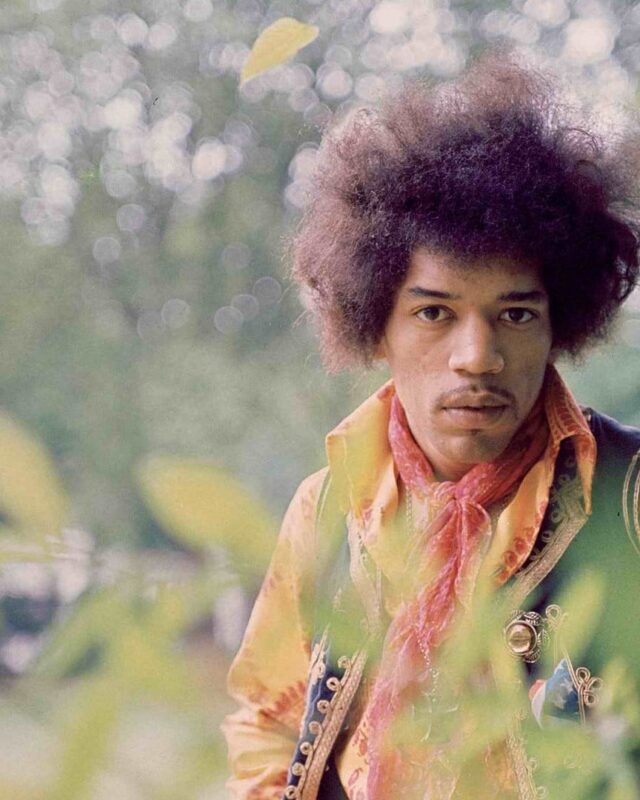
Electric Lady Studios
In 1968, Hendrix and Jeffery jointly invested in the purchase of the Generation Club in Greenwich Village. They had initially planned to reopen the establishment, but when an audit of Hendrix's expenses revealed that he had incurred exorbitant fees by block-booking recording studios for lengthy sessions at peak rates they decided to convert the building into a studio of his own. Hendrix could then work as much as he wanted while also reducing his recording expenditures, which had reached a reported $300,000 annually.
Architect and acoustician John Storyk designed Electric Lady Studios for Jimi Hendrix, who requested that they avoid right angles where possible. With round windows, an ambient lighting machine, and a psychedelic mural, Storyk wanted the studio to have a relaxing environment that would encourage Hendrix's creativity. The project took twice as long as planned and cost twice as much as Hendrix and Jeffery had budgeted, with their total investment estimated at $1 million.
Hendrix first used Electric Lady Studios on June 15, 1970, when he jammed with Steve Winwood and Chris Wood of Traffic; the next day, he recorded his first track there, "Night Bird Flying". The studio officially opened for business on August 25, and a grand opening party was held the following day. Immediately afterwards, Hendrix left for England; he never returned to the States. He boarded an Air India flight for London with Cox, joining Mitchell for a performance as the headlining act of the Isle of Wight Festival on August 31, 1970.
European tour
When the European leg of the Cry of Love tour began, Jimi Hendrix was longing for his new studio and creative outlet, and was not eager to fulfill the commitment. On September 2, 1970, he abandoned a performance in Aarhus, Denmark after three songs, stating: "I've been dead a long time". Four days later, he gave his final concert appearance, at the Isle of Fehmarn Festival in West Germany.
He received cheers and jeers from fans in response to his cancellation of a show scheduled for the end of the previous night's bill due to heavy rain and the risk of electrocution. Immediately after the festival, Hendrix, Mitchell and Cox traveled to London.
Three days after the performance, Cox, who was suffering from severe paranoia after either taking LSD or being given it unknowingly, quit the tour and went to stay with his parents in Pennsylvania. Within days of Hendrix's arrival in England, he had spoken with Chas Chandler, Alan Douglas, and others about leaving his manager, Michael Jeffery. On September 16, Hendrix performed in public for the last time during an informal jam at Ronnie Scott's Jazz Club in Soho with Eric Burdon and his latest band, War. They began by playing a few of their recent hits, and after a brief intermission Hendrix joined them during "Mother Earth" and "Tobacco Road". He died less than 48 hours later.
Drugs and alcohol
Jimi Hendrix entered a small club in Clarksville, Tennessee, in July 1962, drawn in by live music. He stopped for a drink and ended up spending most of the $400 (equivalent to $4,029 in 2023) that he had saved during his time in the Army. "I went in this jazz joint and had a drink," he explained. "I liked it and I stayed. People tell me I get foolish, good-natured sometimes. Anyway, I guess I felt real benevolent that day.
I must have been handing out bills to anyone that asked me. I came out of that place with sixteen dollars left." Alcohol eventually became "the scourge of his existence, driving him to fits of pique, even rare bursts of atypical, physical violence". Roby and Schreiber assert that Hendrix first used LSD when he met Linda Keith in late 1966. Shapiro and Glebbeek, however, assert that Hendrix used it in June 1967 at the earliest while attending the Monterey Pop Festival.

According to Hendrix biographer Charles Cross, the subject of drugs came up one evening in 1966 at Keith's New York apartment. One of Keith's friends offered Hendrix "acid", a street name for LSD, but Hendrix asked for LSD instead, showing what Cross describes as "his naivete and his complete inexperience with psychedelics". Before that, Hendrix had only sporadically used drugs, including cannabis, hashish, amphetamines, and occasionally cocaine. After 1967, he regularly used cannabis, hashish, LSD, and amphetamines, particularly while touring. According to Cross, "few stars were as closely associated with the drug culture as Jimi".
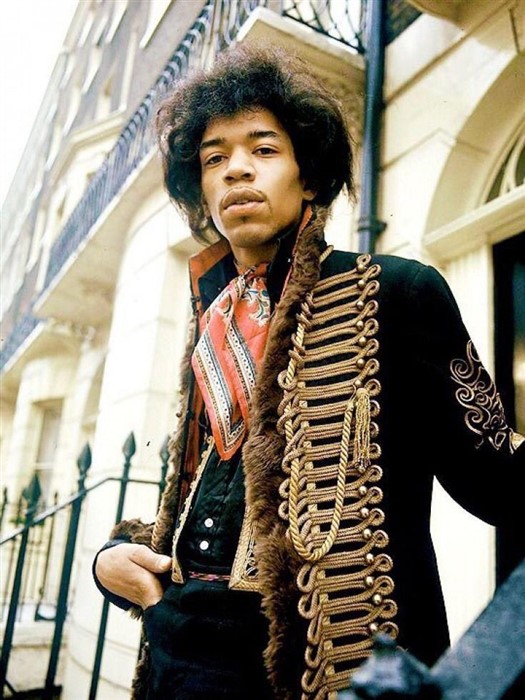
Drug abuse and violence
When Jimi Hendrix drank to excess or mixed drugs with alcohol, often he became angry and violent. His friend Herbie Worthington said Hendrix "simply turned into a bastard" when he drank. According to friend Sharon Lawrence, liquor "set off a bottled-up anger, a destructive fury he almost never displayed otherwise".
In January 1968, the Experience travelled to Sweden to start a one-week tour of Europe. During the early morning hours of the first day, Hendrix got into a drunken brawl in the Hotel Opalen in Gothenburg, smashing a plate-glass window and injuring his right hand, for which he received medical treatment. The incident culminated in his arrest and release, pending a court appearance that resulted in a large fine.
In 1969, Hendrix rented a house in Benedict Canyon, California, that was burglarized. Later, while under the influence of drugs and alcohol, he accused his friend Paul Caruso of the theft, threw punches and stones at him, and chased him away from his house. A few days later Hendrix hit his girlfriend, Carmen Borrero, above her eye with a vodka bottle during a drunken, jealous rage, and gave her a cut that required stitches.
Canadian drug charges and trial
Jimi Hendrix was passing through customs at Toronto International Airport on May 3, 1969, when authorities found a small amount of heroin and hashish in his luggage, and charged him with drug possession. He was released on $10,000 bail (equivalent to $83,085 in 2023), and was required to return on May 5 for an arraignment hearing. The incident proved stressful for Hendrix, and it weighed heavily on his mind during the seven months,
leading up to his December 1969 trial. For the state to prove possession, they had to show that Hendrix knew that the drugs were there. During the jury trial, he testified that a fan had given him a vial of what he thought was legal medication which he put in his bag. He was acquitted of the charges. Mitchell and Redding later revealed that everyone had been warned about a planned drug bust the day before flying to Toronto; both men also stated that they believed that the drugs had been planted in Hendrix's bag without his knowledge.
Death, post-mortem, and burial
Details concerning Jimi Hendrix's last day and death are disputed. He spent much of September 17, 1970, in London with Monika Dannemann, the only witness to his final hours. Dannemann said that she prepared a meal for them at her apartment in the Samarkand Hotel around 11 p.m., when they shared a bottle of wine. She drove him to the residence of an acquaintance at approximately 1:45 a.m., where he remained for about an hour before she picked him up and drove them back to her flat at 3 a.m. She said that they talked until around 7 a.m., when they went to sleep. Dannemann awoke around 11 a.m. and found Hendrix breathing but unconscious and unresponsive. She called for an ambulance at 11:18 a.m., and it arrived nine minutes later. Paramedics transported Hendrix to St Mary Abbots Hospital where doctor John Bannister pronounced him dead at 12:45 p.m. on September 18.
Coroner Gavin Thurston ordered a post-mortem examination which was performed on September 21 by Robert Donald Teare, a forensic pathologist. Thurston completed the inquest on September 28 and concluded that Hendrix aspirated his own vomit and died of asphyxia while intoxicated with barbiturates. Citing "insufficient evidence of the circumstances", he declared an open verdict. Dannemann later revealed that Hendrix had taken nine of her prescribed Vesparax sleeping tablets, 18 times the recommended dosage.
Desmond Henley embalmed Hendrix's body, which was flown to Seattle on September 29. Hendrix's family and friends held a service at Dunlap Baptist Church in Seattle's Rainier Valley on Thursday, October 1; his body was interred at Greenwood Cemetery in nearby Renton, the location of his mother's grave. Family and friends traveled in 24 limousines, and more than 200 people attended the funeral, including Mitch Mitchell, Noel Redding, Miles Davis, John Hammond, and Johnny Winter.
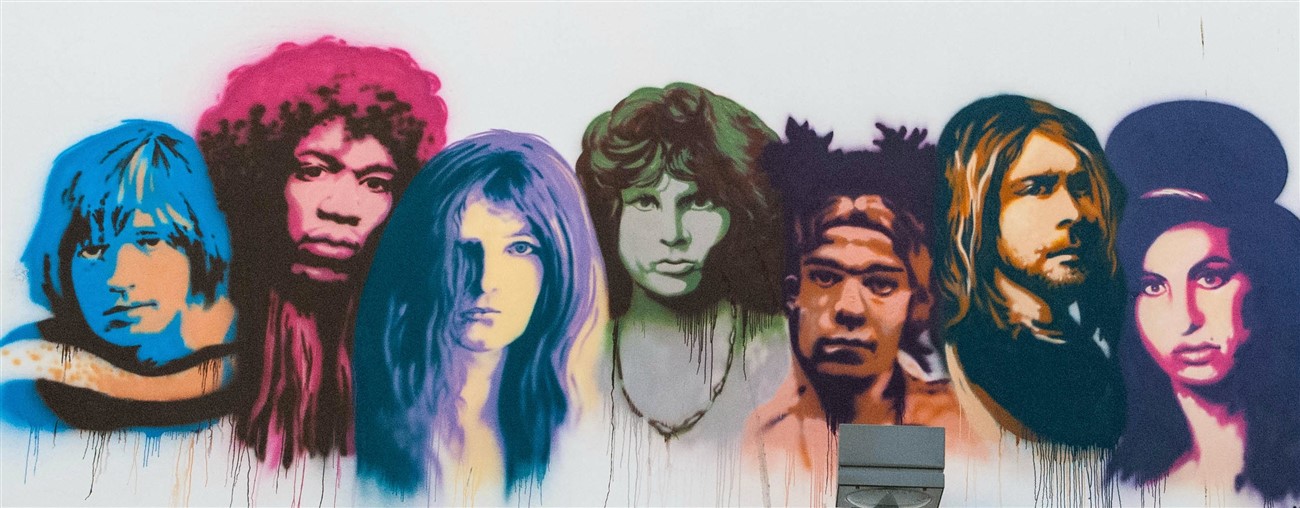
27 Club street mural in Tel Aviv by John Kiss. By Psychology Forever - Own work, CC BY-SA 4.0, https://commons.wikimedia.org/w/index.php?curid=36065648
Jimi Hendrix is often cited as one example of an allegedly disproportionate number of musicians dying at age 27, including Brian Jones, Alan Wilson, Robert Johnson, Jim Morrison, Kurt Cobain, Amy Winehouse and Janis Joplin, a phenomenon referred to as the 27 Club.
Unauthorized and posthumous releases
By 1967, as Jimi Hendrix was gaining in popularity, many of his pre-Experience recordings were marketed to an unsuspecting public as Jimi Hendrix albums, sometimes with misleading later images of Hendrix. The recordings, which came under the control of producer Ed Chalpin of PPX, with whom Hendrix had signed a recording contract in 1965, were often re-mixed between their repeated reissues, and licensed to record companies such as Decca and Capitol.
Hendrix publicly denounced the releases, describing them as "malicious" and "greatly inferior", stating: "At PPX, we spent on average about one hour recording a song. Today I spend at least twelve hours on each song." These unauthorized releases have long constituted a substantial part of his recording catalogue, amounting to hundreds of albums. Some of Hendrix's unfinished fourth studio album was released as the 1971 title The Cry of Love. Although the album reached number three in the US and number two in the UK, producers Mitchell and Kramer later complained that they were unable to make use of all the available songs because some tracks were used for 1971's Rainbow Bridge; still others were issued on 1972's War Heroes.
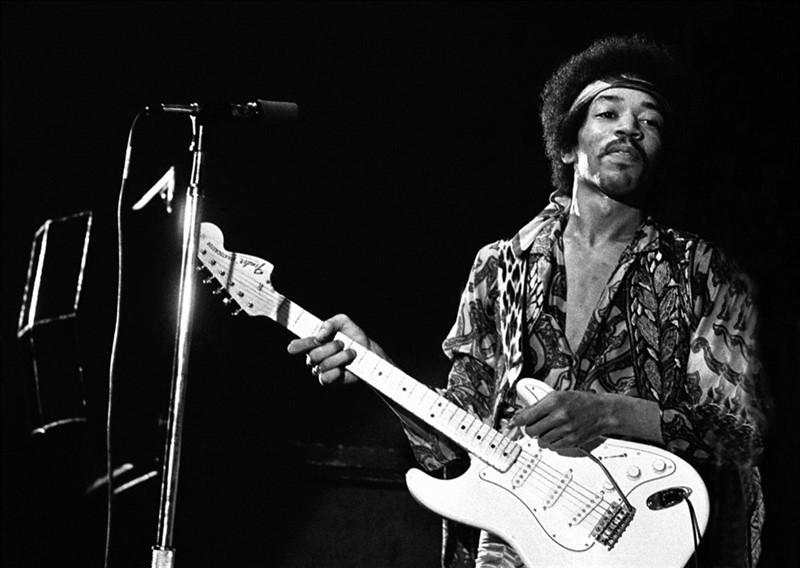
Material from The Cry of Love was re-released in 1997 as First Rays of the New Rising Sun, along with the other tracks that Mitchell and Kramer had wanted to include. Four years after Hendrix's death, producer Alan Douglas acquired the rights to produce unreleased music by Jimi Hendrix; he attracted criticism for using studio musicians to replace or add tracks.
In 1993, MCA Records delayed a multimillion-dollar sale of Hendrix's publishing copyrights because Al Hendrix was unhappy about the arrangement. He acknowledged that he had sold distribution rights to a foreign corporation in 1974, but stated that it did not include copyrights and argued that he had retained veto power of the sale of the catalogue. Under a settlement reached in July 1995, Al Hendrix regained control of his son's song and image rights. He subsequently licensed the recordings to MCA through the family-run company Experience Hendrix LLC, formed in 1995. In August 2009, Experience Hendrix announced that it had entered a new licensing agreement with Sony Music Entertainment's Legacy Recordings division, to take effect in 2010. Legacy and Experience Hendrix launched the 2010 Jimi Hendrix Catalog Project starting with the release of Valleys of Neptune in March of that year. In the months before his death, Jimi Hendrix recorded demos for a concept album tentatively titled Black Gold, now in the possession of Experience Hendrix LLC, but it has not been released.
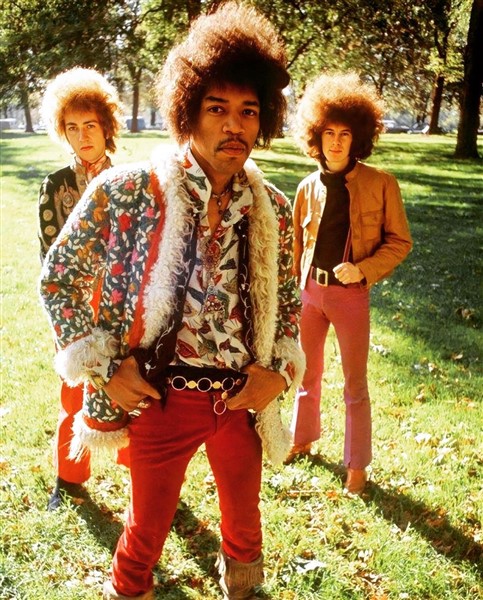
Equipment - Guitars
Jimi Hendrix played a variety of guitars but was most prominently associated with the Fender Stratocaster. He acquired his first in 1966, when a girlfriend loaned him enough money to purchase a used Stratocaster built around 1964. He used it often during performances and recordings. In 1967, he described the Stratocaster as "the best all-around guitar for the stuff we're doing"; he praised its "bright treble and deep bass".
Jimi Hendrix mainly played right-handed guitars that were turned upside down and restrung for left-hand playing. Because of the slant of the Stratocaster's bridge pickup, his lowest string had a brighter sound, while his highest string had a darker sound, the opposite of the intended design. Hendrix also used Fender Jazzmasters, Duosonics, two different Gibson Flying V´s, a Gibson Les Paul, three Gibson SG´s, a Gretsch Corvette, and a Fender Jaguar. He used a white Gibson SG Custom for his performances on The Dick Cavett Show in September 1969, and a black Gibson Flying V during the Isle of Wight festival in 1970.
Amplifiers
During 1965 and 1966, while Hendrix was playing back-up for soul and R&B acts in the US, he used an 85-watt Fender Twin Reverb amplifier. When Chas Chandler brought Jimi Hendrix to England in October 1966, he supplied him with 30-watt Burns amps, which Hendrix thought were too small for his needs. After an early London gig when he was unable to use his Fender Twin, he asked about the Marshall amps he had noticed other groups using.
Years earlier, Mitch Mitchell had taken drum lessons from Marshall founder Jim Marshall, and he introduced Hendrix to Marshall. At their initial meeting, Hendrix bought four speaker cabinets and three 100-watt Super Lead amplifiers; he grew accustomed to using all three in unison. The equipment arrived on October 11, 1966, and the Experience used it during their first tour.
Marshall amps were important to the development of Hendrix's overdriven sound and his use of feedback, creating what author Paul Trynka described as a "definitive vocabulary for rock guitar". Hendrix usually turned all the control knobs to the maximum level, which became known as the Hendrix setting. During the four years prior to his death, he purchased between 50 and 100 Marshall amplifiers. Jim Marshall said Hendrix was "the greatest ambassador" his company ever had.
Effects
One of Hendrix's signature effects was the wah-wah pedal, which he first heard used with an electric guitar in Cream's "Tales of Brave Ulysses", released in May 1967. That July, while performing at The Scene club in New York City, Hendrix met Frank Zappa, whose band The Mothers of Invention were performing at the adjacent Garrick Theater. Hendrix was fascinated by Zappa's application of the pedal, and he experimented with one later that evening.
He used a wah pedal during the opening to "Voodoo Child (Slight Return)", creating one of the best-known wah-wah riffs of the classic rock era. He also uses the effect on "Up from the Skies", "Little Miss Lover", and "Still Raining, Still Dreaming". Hendrix used a Dallas Arbiter Fuzz Face and a Vox wah pedal during recording sessions and performances, but also experimented with other guitar effects. He enjoyed a fruitful long-term collaboration with electronics enthusiast Roger Mayer, whom he once called "the secret" of his sound. Mayer introduced him to the Octavia, an octave-doubling effect pedal, in December 1966, and he first recorded with it during the guitar solo to "Purple Haze".
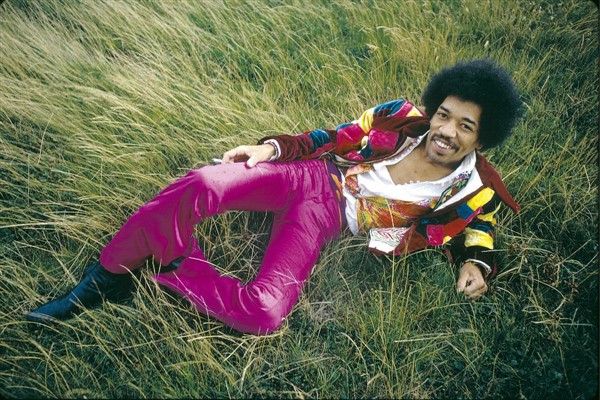
Jimi Hendrix also used the Uni-Vibe, designed to simulate the modulation effects of a rotating Leslie speaker. He uses the effect during his performance at Woodstock and on the Band of Gypsys track "Machine Gun", which prominently features the Uni-vibe along with an Octavia and a Fuzz Face. For performances, he plugged his guitar into the wah-wah, which was connected to the Fuzz Face, then the Uni-Vibe, and finally a Marshall amplifier.
Influences
As an adolescent in the 1950s, Jimi Hendrix became interested in Rock and roll artists such as Elvis Presley, Little Richard, and Chuck Berry. In 1968, he told Guitar Player magazine that electric blues artists Muddy Waters, Elmore James, and B. B. King inspired him during the beginning of his career; he also cited Eddie Cochran as an early influence. Of Muddy Waters, the first electric guitarist of which Hendrix became aware, he said: "I heard one of his records when I was a little boy and it scared me to death because I heard all of these sounds." In 1970, he told Rolling Stone that he was a fan of western swing artist Bob Wills and while he lived in Nashville, the television show the Grand Ole Opry.
Cox stated that during their time serving in the US military, he and Hendrix primarily listened to southern blues artists such as Jimmy Reed and Albert King. According to Cox, "King was a very, very powerful influence". Howlin' Wolf also inspired Hendrix, who performed Wolf's "Killing Floor" as the opening song of his US debut at the Monterey Pop Festival. The influence of soul artist Curtis Mayfield can be heard in Hendrix's guitar playing, and the influence of Bob Dylan can be heard in Hendrix's songwriting; he was known to play Dylan's records repeatedly, particularly Highway 61 Revisited and Blonde on Blonde.
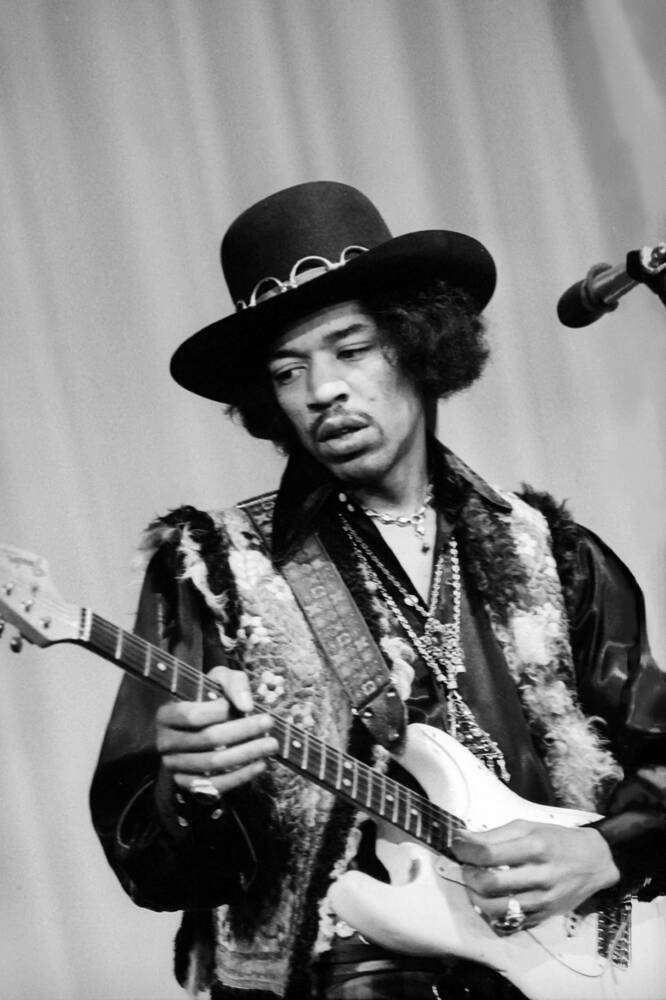
Legacy
The Rock and Roll Hall of Fame biography for the Experience states: "Jimi Hendrix was arguably the greatest instrumentalist in the history of rock music. Jimi Hendrix expanded the range and vocabulary of the electric guitar into areas no musician had ever ventured before. His boundless drive, technical ability and creative application of such effects as wah-wah and distortion forever transformed the sound of Rock and roll." Musicologist Andy Aledort described Jimi Hendrix as "one of the most creative" and "influential musicians that has ever lived". Music journalist Chuck Philips wrote: "In a field almost exclusively populated by white musicians, Jimi Hendrix has served as a role model for a cadre of young black rockers. His achievement was to reclaim title to a musical form pioneered by black innovators like Little Richard and Chuck Berry in the 1950s."
Hendrix favored overdriven amplifiers with high volume and gain. He was instrumental in developing the previously undesirable technique of guitar amplifier feedback and helped to popularize use of the wah-wah pedal in mainstream rock. He rejected the standard barre chord fretting technique used by most guitarists in favor of fretting the low 6th string root notes with his thumb. He applied this technique during the beginning bars of "Little Wing", which allowed him to sustain the root note of chords while also playing melody.
This method has been described as piano style, with the thumb playing what a pianist's left hand would play and the other fingers playing melody as a right hand. Having spent several years fronting a trio, he developed an ability to play rhythm chords and lead lines together, giving the audio impression that more than one guitarist was performing. He was the first artist to incorporate stereophonic phasing effects in Rock music recordings. Holly George-Warren of Rolling Stone wrote: "Hendrix pioneered the use of the instrument as an electronic sound source. Players before him had experimented with feedback and distortion, but Hendrix turned those effects and others into a controlled, fluid vocabulary every bit as personal as the Blues with which he began."
While creating his unique musical voice and guitar style, Hendrix synthesized diverse genres, including Blues, Rhythm & Blues, Soul, British rock, American folk music, 1950s Rock and roll, and jazz. Musicologist David Moskowitz emphasized the importance of blues music in Hendrix's playing style, and according to authors Steven Roby and Brad Schreiber, (Becoming Jimi Hendrix) "He explored the outer reaches of psychedelic rock". His influence is evident in a variety of popular music formats, and he has contributed significantly to the development of Hard rock, Heavy metal, Funk, Post-punk, Grunge, and hip hop music.
His lasting influence on modern guitar players is difficult to overstate; his techniques and delivery have been abundantly imitated by others. Despite his hectic touring schedule and notorious perfectionism, he was a prolific recording artist who left behind numerous unreleased recordings. More than 40 years after his death, Hendrix remains as popular as ever, with annual album sales exceeding that of any year during his lifetime.
As with his contemporary Sly Stone, Jimi Hendrix embraced the experimentalism of white musicians in Progressive rock in the late 1960s and inspired a wave of Progressive soul musicians that emerged by the next decade. He has directly influenced numerous Funk and Funk rock artists, including Prince, George Clinton, John Frusciante of Red Hot Chili Peppers, Eddie Hazel of Funkadelic, and Ernie Isley of the Isley Brothers. Hendrix influenced post-punk guitarists such as John McGeoch of Siouxsie and the Banshees and Robert Smith of The Cure. Grunge guitarists such as Jerry Cantrell of Alice in Chains, Kurt Cobain of Nirvana, and Mike McCready and Stone Gossard of Pearl Jam have cited Hendrix as an influence. Hendrix's influence also extends to many hip hop artists, including De La Soul, A Tribe Called Quest, Digital Underground, Beastie Boys, and Run–D.M.C. Miles Davis was deeply impressed by Jimi Hendrix, and he compared Hendrix's improvisational abilities with those of saxophonist John Coltrane. Desert blues artists from the Sahara desert region including Mdou Moctar and Tinariwen have also acknowledged Hendrix's influence.
Rock and roll fans still debate whether Hendrix actually said that Chicago co-founder Terry Kath was a better guitar player than him, but Kath named Hendrix as a major influence: "But then there was Hendrix, man. Jimi was really the last cat to freak me. Jimi was playing all the stuff I had in my head. I couldn't believe it, when I first heard him. Man, no one can ever do what he did with a guitar. No one can ever take his place."
Hendrix also influenced Black Sabbath, industrial artist Marilyn Manson, blues musician Stevie Ray Vaughan, Randy Hansen, Uli Jon Roth, Kiss's Ace Frehley, Metallica's Kirk Hammett, Aerosmith's Brad Whitford, Judas Priest's Richie Faulkner, instrumental rock guitarist Joe Satriani, King's X singer/bassist Doug Pinnick, Adrian Belew, and Heavy metal virtuoso Yngwie Malmsteen, who said: "Hendrix created modern electric playing, without question ... He was the first. He started it all. The rest is history." "For many", Hendrix was "the preeminent black rocker", according to Jon Caramanica. Members of the Soulquarians, an experimental black music collective active during the late 1990s and early 2000s, were influenced by the creative freedom in Hendrix's music and extensively used Electric Lady Studios to work on their own music.

Recognition and awards
Jimi Hendrix received several prestigious Rock music awards during his lifetime and posthumously. In 1967, readers of Melody Maker voted him the Pop Musician of the Year. In 1968, Rolling Stone declared him the Performer of the Year. Also in 1968, the City of Seattle gave him the keys to the city. Disc & Music Echo newspaper honored him with the World Top Musician of 1969 and in 1970 Guitar Player magazine named him the Rock Guitarist of the Year.
Rolling Stone ranked his three non-posthumous studio albums, Are You Experienced (1967), Axis: Bold as Love (1967), and Electric Ladyland (1968) among the 500 Greatest Albums of All Time. They ranked Jimi Hendrix number one on their list of the 100 greatest guitarists of all time, and number six on their list of the 100 greatest artists of all time. Guitar World's readers voted six of Hendrix's solos among the top 100 Greatest Guitar Solos of All Time: "Purple Haze" (70), "The Star-Spangled Banner" (52; from Live at Woodstock), "Machine Gun" (32; from Band of Gypsys), "Little Wing" (18), "Voodoo Child (Slight Return)" (11), and "All Along the Watchtower" (5). Rolling Stone placed seven of his recordings in their list of the 500 Greatest Songs of All Time: "Purple Haze" (17), "All Along the Watchtower" (47) "Voodoo Child (Slight Return)" (102), "Foxy Lady" (153), "Hey Joe" (201), "Little Wing" (366), and "The Wind Cries Mary" (379). They also included three of Hendrix's songs in their list of the 100 Greatest Guitar Songs of All Time: "Purple Haze" (2), "Voodoo Child" (12), and "Machine Gun" (49).
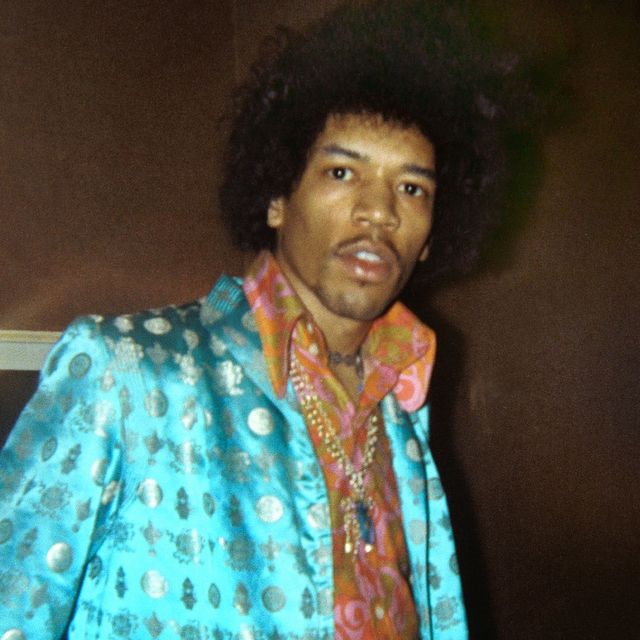
A star on the Hollywood Walk of Fame was dedicated to Hendrix on November 14, 1991, at 6627 Hollywood Boulevard. The Jimi Hendrix Experience was inducted into the Rock and Roll Hall of Fame in 1992, and the UK Music Hall of Fame in 2005. In 1998, Hendrix was inducted into the Native American Music Hall of Fame during its first year. In 1999, readers of Rolling Stone and Guitar World ranked Hendrix among the most important musicians of the 20th century.
In 2005, his debut album, Are You Experienced, was one of 50 recordings added that year to the US National Recording Registry in the Library of Congress, "to be preserved for all time ... as part of the nation's audio legacy". In Seattle, November 27, 1992, which would have been Hendrix's 50th birthday, was made Jimi Hendrix Day, largely due to the efforts of his boyhood friend, guitarist Sammy Drain.
The Blue plaque identifying Hendrix's former residence at 23 Brook Street, London, was the first issued by English Heritage to commemorate a pop star. Next door is the former residence of George Frideric Handel, 25 Brook Street, which opened to the public as the Handel House Museum in 2001. From 2016 the museum made use of the upper floors of 23 for displays about Hendrix and was rebranded as Handel & Hendrix in London.
A memorial statue of Hendrix playing a Stratocaster stands near the corner of Broadway and Pine Streets in Seattle. In May 2006, the city renamed a park near its Central District Jimi Hendrix Park, in his honor. In 2012, an official historic marker was erected on the site of the July 1970 Second Atlanta International Pop Festival near Byron, Georgia. The marker text reads, in part: "Over thirty musical acts performed, including rock icon Jimi Hendrix playing to the largest American audience of his career."
Jimi Hendrix's music has received a number of Hall of Fame Grammy awards, starting with a Lifetime Achievement Award in 1992, followed by two Grammys in 1999 for his albums Are You Experienced and Electric Ladyland; Axis: Bold as Love received a Grammy in 2006. In 2000, he received a Hall of Fame Grammy award for his original composition, "Purple Haze", and in 2001, for his recording of Bob Dylan's "All Along the Watchtower". Hendrix's rendition of "The Star-Spangled Banner" was honored with a Grammy in 2009.

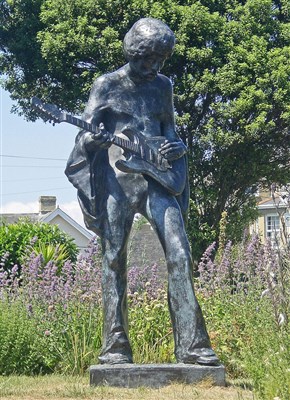
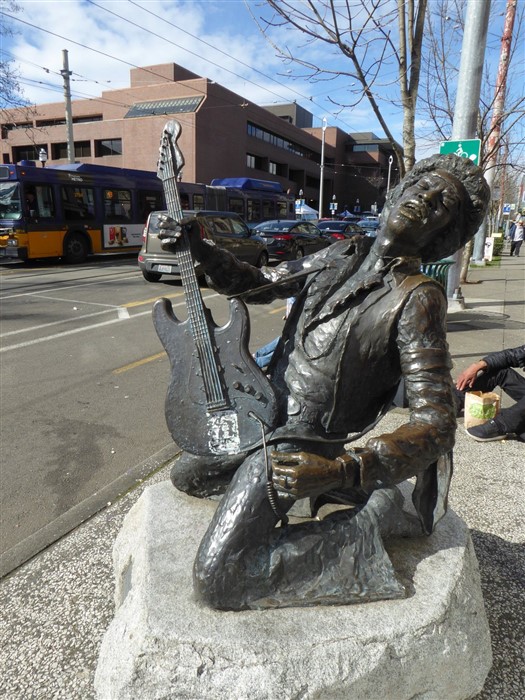
The United States Postal Service issued a commemorative postage stamp honoring Hendrix in 2014. On August 21, 2016, Jimi Hendrix was inducted into the Rhythm and Blues Music Hall of Fame in Dearborn, Michigan. The James Marshall "Jimi" Hendrix United States Post Office in Renton Highlands near Seattle, about a mile from Hendrix's grave and memorial, was renamed for Hendrix in 2019.
On June 23, 2019, the Band of Gypsys were inducted into the Rhythm and Blues Music Hall of Fame, at the Charles H. Wright Museum of African American History in Detroit, Michigan. Billy Cox, the last surviving member of the group, was on hand to accept, along with representatives of the Buddy Miles and Hendrix estates.
Albums
Are You Experienced (1967)
Axis: Bold as Love (1967)
Electric Ladyland (1968)
Band of Gypsys (1970) live
Woodstock: Music from the Original Soundtrack and More (1970) live
Historic Performances Recorded at the Monterey International Pop Festival (1970)
The Cry of Love (1971)
Woodstock Two (1971) live
Experience (1971)
Isle of Wight/Atlanta Pop Festival (1971)
Isle of Wight (1971)
Hendrix in the West (1972)
More Experience (1972)
Soundtrack Recordings from the Film Jimi Hendrix (1973)
The Jimi Hendrix Concerts (1982)
Jimi Plays Monterey (1986)
Johnny B. Goode (1986)
Band of Gypsys 2 (1986)
Live at Winterland (1987)
Radio One (1988)
Live & Unreleased: The Radio Show (1989)
Stages (1991)
Live Isle of Wight '70 (1991)
Woodstock (1994)
Message to Love: The Isle of Wight Festival 1970 (1996)
BBC Sessions (1998)
Live at the Fillmore East (1999)
Live at Woodstock (1999)
Blue Wild Angel: Live at the Isle of Wight (2002)
Live at Berkeley (2003)
Live at Monterey (2007)
Winterland (2011)
Miami Pop Festival (2013)
Freedom: Atlanta Pop Festival (2015)
Machine Gun: The Fillmore East First Show (2016)
Songs for Groovy Children: The Fillmore East Concerts (2019)
Live in Maui (2020)
Los Angeles Forum: April 26, 1969 (2022)
Members Are You Experienced
Jimi Hendrix – guitars, vocals, piano
Noel Redding – bass guitar, rhythm guitar, backing vocals
Mitch Mitchell – drums, percussion, backing vocals
Additional members
The Breakaways – backing vocals on "Hey Joe"
Dave Siddle – engineering on "Manic Depression", "Can You See Me", "Love or Confusion", "I Don't Live Today", "Fire", "Remember", "Hey Joe", "Stone Free", "Purple Haze", "51st Anniversary", and "The Wind Cries Mary"
Eddie Kramer – engineering on "The Wind Cries Mary", "Are You Experienced?", and "Red House"; additional engineering on "Love or Confusion", "Fire", "Third Stone from the Sun", and "Highway Chile"
Mike Ross – engineering on "Foxy Lady", "Red House", and "Third Stone from the Sun"
Members Axis: Bold as Love
Jimi Hendrix – vocals, electric guitar, piano, recorder, glockenspiel on "Little Wing", harpsichord on "Bold as Love", voice of Mr. Paul Caruso on "EXP"
Mitch Mitchell – drums, backing vocals, interviewer on "EXP"
Noel Redding – bass guitars (four- and eight-string), backing vocals, foot stomping on "If 6 Was 9", lead vocals on "She's So Fine"
Additional personnel
Gary Leeds – foot stamping on "If 6 Was 9"
Graham Nash – foot stamping on "If 6 Was 9", backing vocals on "You Got Me Floating'"
Trevor Burton – backing vocals on "You Got Me Floating'"
Roy Wood – backing vocals on "You Got Me Floating'"
Production
Chas Chandler – producer, foot stomping on "If 6 Was 9"
Eddie Kramer – chief engineer
George Chkiantz, Andy Johns and Terry Brown – engineers
Cover art – David King, Roger Law, painted heads based on a Karl Ferris group portrait (front)
Donald Silverstein – photography (UK inner portrait)
Members Electric Ladyland
Jimi Hendrix – vocals, guitars, piano, percussion, electric harpsichord; bass guitar on "Have You Ever Been (To Electric Ladyland)", "Long Hot Summer Night", "Gypsy Eyes", "1983...(Merman I Should Turn To Be", "House Burning Down", and "All Along the Watchtower"; comb and tissue paper on "Crosstown Traffic"
Noel Redding – bass guitar, backing vocals on "Crosstown Traffic", "Little Miss Strange", "Come On", "Burning of the Midnight Lamp", and "Voodoo Child (Slight Return)"; acoustic guitar and lead vocals on "Little Miss Strange"
Mitch Mitchell – drums, percussion, backing vocals on all tracks except "Rainy Day, Dream Away" and "Still Raining, Still Dreaming"; lead vocals on "Little Miss Strange"
Additional musicians
Al Kooper – piano on "Long Hot Summer Night"
Dave Mason – twelve-string guitar on "All Along the Watchtower", backing vocals on "Crosstown Traffic"
Steve Winwood – Hammond organ on "Voodoo Chile"
Jack Casady – bass guitar on "Voodoo Chile"
Freddie Smith – tenor saxophone on "Rainy Day, Dream Away" and "Still Raining, Still Dreaming"
Mike Finnigan – organ on "Rainy Day, Dream Away" and "Still Raining, Still Dreaming"
Buddy Miles – drums on "Rainy Day, Dream Away" and "Still Raining, Still Dreaming"
Larry Faucette – congas on "Rainy Day, Dream Away" and "Still Raining, Still Dreaming"
Chris Wood – flute on "1983... (A Merman I Should Turn to Be)"
Brian Jones – percussion on "All Along the Watchtower"
The Sweet Inspirations – backing vocals on "Burning of the Midnight Lamp"
Production
Jimi Hendrix – producer, mixing, arrangements, US LP issue liner notes
Eddie Kramer, Gary Kellgren – engineers, mixing
David King – UK album sleeve design
David Montgomery – UK outer sleeve and inside photography
Karl Ferris – US cover design
Ed Thrasher – US art direction
Linda Eastman, David Sygall – US cover photography
Digital remastering
Lee Herschberg – initial compact disc release
Joe Gastwirt – 1989 compact disc release
Eddie Kramer, George Marino – 1997 compact disc release
Bernie Grundman, Scott Sedilo – 2018 anniversary compact disc release
Source: Wikipedia

